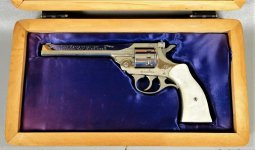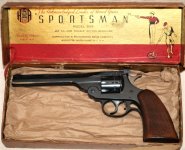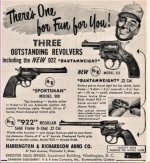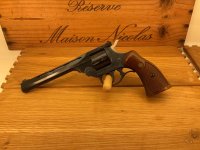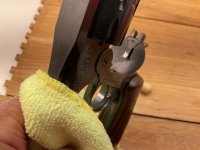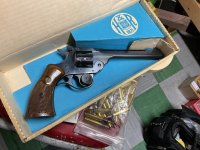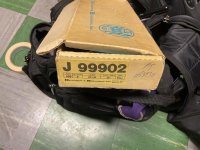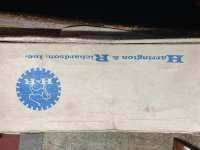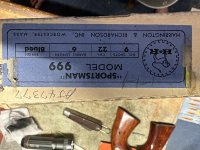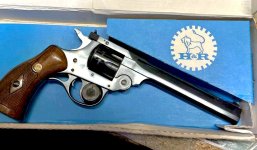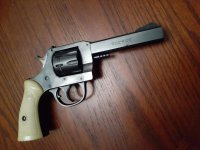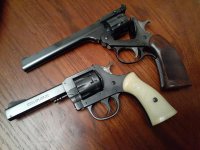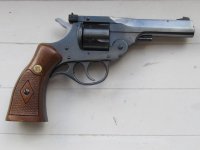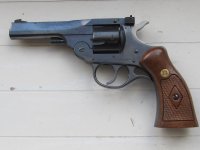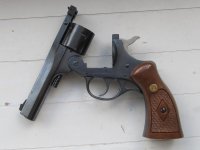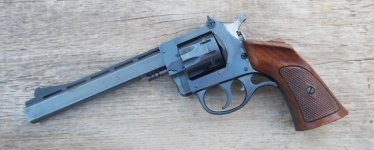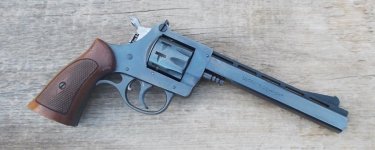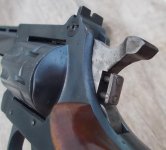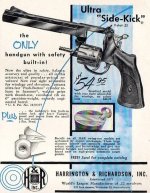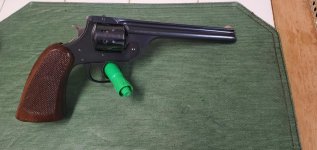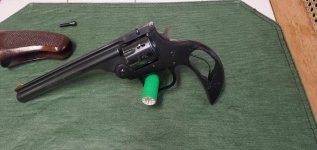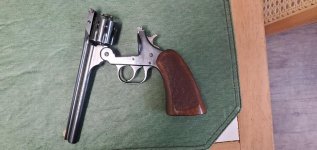The following link will let you view the January, 1935 issue of The American Rifleman. On page 46 there's a shooting test report on H&R's, which includes the single action Sportsman: https://ia601801.us.archive.org/34/...1_83_1/sim_american-rifleman_1935-01_83_1.pdf
You are using an out of date browser. It may not display this or other websites correctly.
You should upgrade or use an alternative browser.
You should upgrade or use an alternative browser.
The Harrington & Richardson Sportsman
- Thread starter Goony
- Start date
.357magger
Member
The following link will let you view the January, 1935 issue of The American Rifleman. On page 46 there's a shooting test report on H&R's, which includes the single action Sportsman: https://ia601801.us.archive.org/34/...1_83_1/sim_american-rifleman_1935-01_83_1.pdf
Thanks Goony.
Interesting stuff.
Don't know if I enjoyed page 46 more or the thought of buying Colt SAAs for $18.00 (by mail no less) in the advertisement section.
Last edited:
bearfoot
US Veteran
Well, the top one should have been made after 1952 but before 1967, while the bottom one could well be as late as the one I posted above. H&R's are generally pretty easy to date as the letter(s) serial number prefix advanced alphabetically (albeit with some gaps) each year. Here's the rundown -
A 1940
B 1941
C 1942
D 1943 *
E 1944
F 1945
G 1946
H 1947
I 1948
J 1949
K 1950
L 1951
M 1952
N 1953
P 1954
R 1955 **
S 1956 ***
T 1957
U 1958 ****
V 1959
W 1960
X 1961
Y 1962
Z 1963
AA 1964
AB 1965
AC 1966
AD 1967
AE 1968
AF 1969
AG 1970
AH 1971
AJ 1972
AL 1973
AM 1974
AN 1975
AP 1976
AR 1977
AS 1978
AT 1979
AU 1980
AX 1981
AY 1982
AZ 1983
BA 1984
BB 1985
BC 1986
* For some 1930's Sportsmans a "D" serial number prefix did not denote year of manufacture but rather "double action".
** An "R" serial number prefix will also be found on the circa 1940 Model 196 Eureka Sportsman.
*** For some 1930's Sportsmans an "S" serial number prefix did not denote year of manufacture but rather "single action".
**** A "U" serial number prefix will also be found on the circa 1938-39 Model 777 Ultra Sportsman.
In 1981 H&R offered a special, engraved version of the 999 to commemorate their 110th anniversary. These "1 of 999" revolvers were numbered from 999001 to 999999.
After Harrington & Richardson proper had ceased operations, manufacture of 999's continued under the aegis of New England Firearms (H&R 1871) utilizing a new series of serial number prefixes -
HA 1987
HB 1988
HC 1989
HD 1990
HE 1991
HF 1992
HG 1993
HH 1994
HJ 1995
HK 1996
HL 1997
HM 1998
HN 1999
Additional notes on 1930's era Sportsman serial numbers -
Since H&R's records from this period aren't extant, an accounting of serial numbers can only be based on observation and to some degree conjecture.
It may be that prototype and pre-production samples were numbered beginning with 1 (or 01), while regular production started at 101. Low serial numbers have been documented up into the 1600 range. By the 3000 range, the "S" prefix (for "single action") had appeared, and by 4000, the "D" prefix (for "double action") was being applied. It isn't at all clear whether the single and double actions shared a serial number sequence with the "S" or "D" prefix being utilized as appropriate, or if each was numbered in separate sequences (so that there could theoretically exist two guns with the same serial number save for the preceding "D" or "S"). It seems certain that the Ultra Sportsman and Eureka Sportsman had their own serial number sequences (preceded by "U" and "R" respectively). In any case, at some point above the D28000 range (circa 1937), the "D" at least was dropped and serial numbering reverted to a straightforward all numeric progression that reached as high as perhaps 90000, ending there as the practice of date code prefixes (starting with "A") with yearly recurring numbers was adopted in 1940.
how can i keep this list? thank you for the info.
how can i keep this list? thank you for the info.
You can copy and paste the text to a text file.
Attachments
The "End of Chisholm Trail" Centennial Commemorative
This Model 999 Sportsman variant isn't cataloged in Bill Goforth's book, and information on them is almost nonexistent. Note the unfluted cylinder and "pearl" grips. Aside from their dating to 1967, it remains unknown just how many were made, what their serial numbering range was, and whether the finish was nickel or in fact chrome. There has been one sold that was purported to be a prototype: Very Rare Harrington & Richardson Model 999 End of Chisholm Trail Centennial Prototype Revolver
This Model 999 Sportsman variant isn't cataloged in Bill Goforth's book, and information on them is almost nonexistent. Note the unfluted cylinder and "pearl" grips. Aside from their dating to 1967, it remains unknown just how many were made, what their serial numbering range was, and whether the finish was nickel or in fact chrome. There has been one sold that was purported to be a prototype: Very Rare Harrington & Richardson Model 999 End of Chisholm Trail Centennial Prototype Revolver
Attachments
I own these two Sportsman pistols. Both made around 1938. They are fun pistols and when taken to the range usually draw some attention, since top break 22s are not seen too often! I also own an Iver Johnson Supershot Sealed 8, which I think id a bit better made. Also interesting in the cleaning and oiling it says to uses 3-In-One for lubrication. I think I'll pass on that suggestion!
Oh, I paid $150 for the one in the box back in 2003.

Oh, I paid $150 for the one in the box back in 2003.

Last edited:
I came across a photo that shows what a Sportsman box looked like in 1952. I'm also posting an advertisement from the prior year. Note that at this time, H&R was still producing the Sportsman utilizing the prewar (birdshead or "Rice") frame pattern.
Attachments
There are a lot of nice Sportsmen pictured above, kinda renewed an itch. So I started looking for a Sportsman.
Been watching the Sportsman 999 for years but never bought one. Was watching the tables at the Berea gun show today and found one for sale in excellent condition with the box. It was at 575.00 and he wouldn’t budge, bought it. He said it would sell eventually because of the condition, ones this nice sell for more online. Been watching gunbroker and he was right. It looks to have not been fired much at all, no blue wear on the recoil shield by the firing pin. Made in 1979. Gonna shoot it Tuesday morning at the old guys shoot, can’t wait.
The trigger in single action is sorta heavy, any way to make it lighter?? Same in double action, Larry
Been watching the Sportsman 999 for years but never bought one. Was watching the tables at the Berea gun show today and found one for sale in excellent condition with the box. It was at 575.00 and he wouldn’t budge, bought it. He said it would sell eventually because of the condition, ones this nice sell for more online. Been watching gunbroker and he was right. It looks to have not been fired much at all, no blue wear on the recoil shield by the firing pin. Made in 1979. Gonna shoot it Tuesday morning at the old guys shoot, can’t wait.
The trigger in single action is sorta heavy, any way to make it lighter?? Same in double action, Larry
Attachments
dsf
Member
^
I have a few SA and DA Sportmen revolvers. Regarding improving the SA trigger, yes it can be done and is not nearly as difficult as it may seem.
H&R (and IJ) actions are quite different from S&W, Colt, Ruger in that the SA sear is not part of the trigger but is a separate tab that pivots between the trigger and hammer. You can actually drop the hammer without pressing the trigger when the hammer is fully cocked. Improving the SA trigger pull is simply a matter of cleaning up the SA sear and sear notch by removing the trigger, sear notch lever and hammer.
Removing the hammer is pretty straightforward if you want to limit yourself to that much disassembly.
RE the DA pull, there's not much camming action to it. Pretty much a straight up lift. So unless you lighten the spring I don't think there's a whole lot that can be done.
A few photos, just for the heck of it -
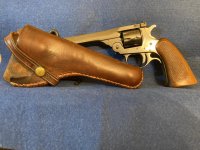
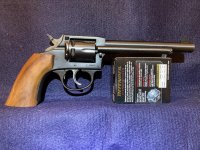
Sear lever is readily visible on the IJ.
I have a few SA and DA Sportmen revolvers. Regarding improving the SA trigger, yes it can be done and is not nearly as difficult as it may seem.
H&R (and IJ) actions are quite different from S&W, Colt, Ruger in that the SA sear is not part of the trigger but is a separate tab that pivots between the trigger and hammer. You can actually drop the hammer without pressing the trigger when the hammer is fully cocked. Improving the SA trigger pull is simply a matter of cleaning up the SA sear and sear notch by removing the trigger, sear notch lever and hammer.
Removing the hammer is pretty straightforward if you want to limit yourself to that much disassembly.
RE the DA pull, there's not much camming action to it. Pretty much a straight up lift. So unless you lighten the spring I don't think there's a whole lot that can be done.
A few photos, just for the heck of it -


Sear lever is readily visible on the IJ.
Last edited:
- Joined
- Nov 10, 2019
- Messages
- 69
- Reaction score
- 313
Lots of knowledgeable H&R guys here. What are thoughts on the 929 Sidekick? I’ve got my eye on one at a LGS. Very nice shooter. Which is what I’d do with it. 4” black plastic grips. I haven’t handled it yet but probably will this week.
DGNY
Member
Thanks for this illuminating discussion. Only have one .22 H & R, from 1969 with F prefix. That is a 4 inch 926, an accurate item with a decent trigger.
ldausmc1369
US Veteran
Just checked! Mine was made in 1968! Thanks for the chart, OP! Grandson loves to shoot it!
.357magger
Member
Lots of knowledgeable H&R guys here. What are thoughts on the 929 Sidekick? I’ve got my eye on one at a LGS. Very nice shooter. Which is what I’d do with it. 4” black plastic grips. I haven’t handled it yet but probably will this week.
I was first taught to shoot a handgun by my Dad with the Sidekick below. It's from the late 50's, and still going strong. They don't garner a lot of attention in the collecting world, but they supplied "the workingman" with a lower cost, dependable revolver providing years of use.
The 926 round barrel is more common, with the 929 Slabside Sidekick being a bit harder to find. H&R also made a 4" companion 32 Long Slabside. I lost out on an auction last month one one, also with the "Tennessee Ivory" (plastic
When I was a kid I thought these grips were ivory. Man, I was in high style when Dad allowed me to carry it on our plinking walks.
Attachments
Last edited:
Thuer
Member
Thanks for posting Goony.
I do have a H&R model 926 in .38 s&w. I wonder why it is in that caliber. Even in 1974 when this revolver was build it was not a populair caliber. Or I am wrong. But because it is a topbreak revolver it was probebly the best choice. It is well made and I love it. The condition is great. Before I did take the pictures I could better whipe the spots off.
I do have a H&R model 926 in .38 s&w. I wonder why it is in that caliber. Even in 1974 when this revolver was build it was not a populair caliber. Or I am wrong. But because it is a topbreak revolver it was probebly the best choice. It is well made and I love it. The condition is great. Before I did take the pictures I could better whipe the spots off.
Attachments
Not a Sportsman, but rather a Model 939 Ultra "Side-Kick" made in 1958 (the first year of production). The closeup shot shows the spring loaded button at the rear of the hammer which when pushed in releases the swing out cylinder. This button is a feature not found on any other H&R.
Other details include an aluminum ventilated rib and machine turning on the sides of the hammer (albeit subdued). The action is silky smooth. Like the Sportsman, clearly this was intended to be a a revolver that would appeal to a more sophisticated customer than did the company's generally more utilitarian offerings.
As illustrated by the advertisement, an integral key operated safety lock became available the year following this model's introduction. Some examples will be found with a "VU" serial number prefix which has been interpreted to indicate guns originally manufactured in 1958 but retrofitted with the new safety lock prior to their distribution in 1959.
Other details include an aluminum ventilated rib and machine turning on the sides of the hammer (albeit subdued). The action is silky smooth. Like the Sportsman, clearly this was intended to be a a revolver that would appeal to a more sophisticated customer than did the company's generally more utilitarian offerings.
As illustrated by the advertisement, an integral key operated safety lock became available the year following this model's introduction. Some examples will be found with a "VU" serial number prefix which has been interpreted to indicate guns originally manufactured in 1958 but retrofitted with the new safety lock prior to their distribution in 1959.
Attachments
Last edited:
22 Special
It would seem that this "22 Special" made around 1935 could be part of this conversation. For a Depression era, budget priced gun, the fit and finish are amazing. The sights leave a lot to be desired, but it's a really fun shooter. The barrel to frame lock-up is bank vault tight. The hourglass shaped rib is a nice detail.
It would seem that this "22 Special" made around 1935 could be part of this conversation. For a Depression era, budget priced gun, the fit and finish are amazing. The sights leave a lot to be desired, but it's a really fun shooter. The barrel to frame lock-up is bank vault tight. The hourglass shaped rib is a nice detail.
Attachments
A very special (and pricey) Sportsman: Engraved Harrington & Richardson Sportsman Revolver | Rock Island Auction
Edit - Within just several months this very same gun was again sold at auction (for a profit): Engraved Harrington & Richardson Sportsman Revolver | Rock Island Auction
Edit - Within just several months this very same gun was again sold at auction (for a profit): Engraved Harrington & Richardson Sportsman Revolver | Rock Island Auction
Last edited:
Similar threads
- Locked
- Replies
- 45
- Views
- 8K
- Replies
- 28
- Views
- 15K
- Locked
- Replies
- 26
- Views
- 10K
- Locked
- Replies
- 10
- Views
- 6K

